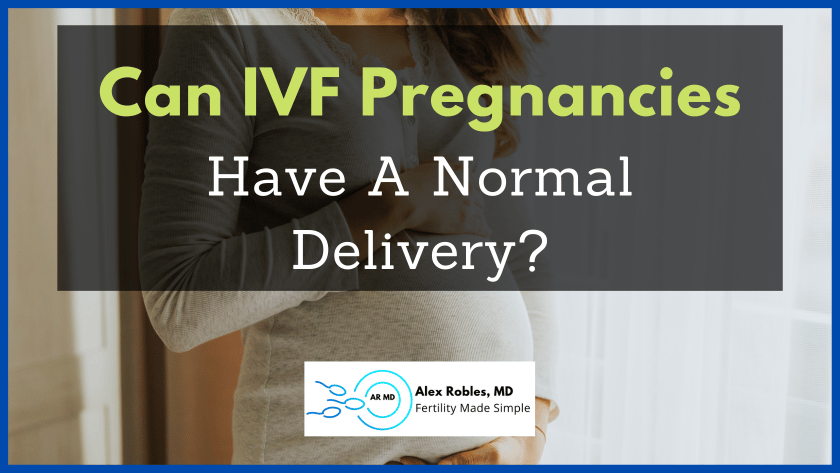While in vitro fertilization (IVF) pregnancies may come with some increased risks; it is important to note that a majority of these pregnancies result in normal vaginal delivery.
In this article, you will learn the risks and benefits of IVF pregnancies and explore the factors that may affect your birth options.

Can An IVF Pregnancy Have A Normal Delivery?
Yes, an IVF pregnancy can have a normal delivery. In fact, most women who conceive through IVF go on to have successful vaginal deliveries. (source)
That said, there is a higher risk for c-sections in IVF pregnancies compared to natural conceptions.
Studies show at least a 50-90% increased risk for cesarean delivery in IVF pregnancies. (source)
However, these numbers are likely due to specific factors commonly seen with IVF including: multiple pregnancies (twins or more), maternal age, and pre-existing medical conditions.
Regardless, these factors can also apply to natural pregnancies, and they don’t automatically mean a cesarean delivery will be necessary.
5 Factors Affecting Mode Of Delivery
There are many factors that can influence the likelihood of cesarean section in women who have undergone infertility treatment. Unfortunately, some of these factors are unmodifiable.
Advanced Maternal Age
Maternal age plays a significant role in determining the success of vaginal delivery. As women get older, the risk of complications during pregnancy and delivery increases. All patients over 35 have a higher risk of having a c-section than younger patients.
Single Vs. Multiple Pregnancies
Pregnancies resulting from IVF treatment have a higher chance of multiple gestations, such as twins or triplets. The likelihood of vaginal delivery decreases with multiples due to potential complications for both the mom and babies. Thankfully, more and more IVF babies are coming from singleton pregnancies.
Health Conditions
Existing health conditions can also impact the chances of safe labor and delivery. Some diseases like hypertension, diabetes, or obesity may reduce the likelihood of successful vaginal delivery.
Fetal Well-Being
Similarly, maternal health will likely impact the health of the baby. If the baby is not growing appropriately or shows signs of distress- vaginal birth is less likely.
Previous Birth History
If you previously had a baby, your prior mode of delivery can influence the outcome of subsequent deliveries.
A history of successful vaginal births could indicate a higher likelihood of another vaginal delivery. On the other hand, a history of complicated deliveries or previous cesarean sections may reduce the chances of a vaginal delivery.
Steps to Increase Your Chances of A Natural Birth
Prenatal Care
Regular prenatal checkups are crucial for a healthy pregnancy and normal delivery. Prenatal visits will help your provider closely monitor your health and the growth of the fetus, allowing them to detect any potential problems early.
Make sure to attend all appointments and follow your healthcare provider’s advice.
Physical Activity
Engaging in regular physical activity strengthens the body and prepares it for labor. The American College of Obstetricians and Gynecologists (ACOG) recommends 30 minutes of moderate-intensity physical activity most days of the week. (source)
Exercise can help build muscle strength, improve posture, and reduce stress and cesarean deliveries. As always, consult your doctor before starting any fitness program.
Healthy Diet
A balanced and nutritious diet can contribute to a healthy pregnancy and reduce the likelihood of excessive weight gain. Gaining more than the recommended amount of weight during pregnancy can increase the risk of cesarean delivery.
Do your best to include fruits, vegetables, whole grains, lean proteins, and healthy fats in your diet. Also, stay hydrated and avoid excessive liquid calories.
Other Delivery Complications To Consider
Studies show that IVF pregnancies also increase the risk of other adverse pregnancy outcomes compared to the general population.
On the fetal side, these include preterm birth, low birth weight babies, and congenital anomalies.
Maternal complications may include placenta previa, placental abruption, gestational diabetes, preeclampsia (high blood pressure), and bleeding.
It is important to note that these risk factors often correlate with the age and health of the patient as well as the number of babies in the pregnancy.
Other Related Questions
Can You Have A Normal Delivery With IVF Twins?
Yes, it is possible to have a vaginal delivery with an IVF twin pregnancy. However, the decision depends on many factors, including the babies’ position and size, their health, and the mother’s health. Your obstetrician will assess each case individually before suggesting the most suitable delivery method.
When Should An IVF Baby Be Delivered?
An IVF baby should be delivered around the same time as a naturally conceived baby, at around 40 weeks of pregnancy. However, individual circumstances may require earlier or later delivery, which your healthcare provider will determine through close monitoring.
What Percentage Of IVF Pregnancies Go Full Term?
It isn’t easy to give an exact percentage. Many IVF pregnancies progress to full term, similarly to a natural conception. The likelihood of going full-term depends on the mother’s health, age, and fetal status. Following medical advice and attending regular checkups is essential to maximize the likelihood of a long and healthy pregnancy.
How To Calculate Your Delivery Date
To estimate your IVF baby delivery date, add 261 days to your embryo transfer date (assuming you had a blastocyst transfer).
Are There Any Side Effects Of IVF After Delivery?
IVF does not cause side effects after delivery. Fertility treatments may cause short-term side effects such as headaches, bloating and abdominal pain. However, these usually resolve on their own very quickly after you complete your IVF cycle.
After giving birth, potential complications or side effects would relate to the delivery process itself.
Are All IVF Patients High Risk?
No, not all IVF patients are high-risk. The risk level is based on the mother’s age, health, and number of babies in the pregnancy. One key difference between IVF and natural pregnancy is that all IVF pregnancies get a fetal echocardiogram due to the higher incidence of congenital anomalies.
Conclusion: Fertility Treatment & Natural Delivery
IVF pregnancies are very likely to have normal vaginal birth, similar to natural conceptions. The success rates of a spontaneous delivery depend on various factors, such as the woman’s health, age, fetal health, and medical history.
To maximize your chances of a successful delivery, maintain a healthy lifestyle and adhere to your healthcare provider’s guidance.
Lastly, every pregnancy is unique, and factors influencing the delivery method may change during the course of pregnancy. Consistent communication with medical professionals ensures the best possible outcome for you and the baby.
Other Articles Related To IVF & Complications of Pregnancy
- Ectopic Pregnancy After IVF: What To Look Out For
- Vaginal Bleeding In An IVF Pregnancy: Is It A Miscarriage?
- How Soon Can You Do IVF After A D&C?
Make An Appointment With Dr. Robles To Discuss Your Fertility Options Today!

Alex Robles, MD
Dr. Alex Robles is a Spanish-speaking Latino-American Reproductive Endocrinologist and Infertility specialist in New York City, and a board-certified OBGYN. He has a special interest in health, lifestyle, & nutrition. Make an appointment with Dr. Robles to discuss your fertility options today!
References:
- Luke B, Gopal D, Cabral H, Stern JE, Diop H. Pregnancy, birth, and infant outcomes by maternal fertility status: the Massachusetts Outcomes Study of Assisted Reproductive Technology. Am J Obstet Gynecol. 2017 Sep;217(3):327.e1-327.e14. doi: 10.1016/j.ajog.2017.04.006. Epub 2017 Apr 8. PMID: 28400311; PMCID: PMC5581226.
- Lodge-Tulloch, N.A., Elias, F.T.S., Pudwell, J. et al. Caesarean section in pregnancies conceived by assisted reproductive technology: a systematic review and meta-analysis. BMC Pregnancy Childbirth 21, 244 (2021). https://doi.org/10.1186/s12884-021-03711-x
- Physical Activity and Exercise During Pregnancy and the Postpartum Period Committee Opinion CO Number 804 April 2020
